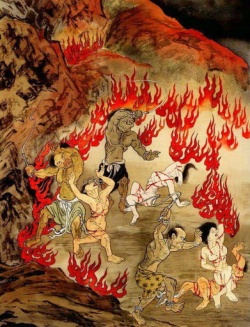Deepening Compassion
Gampopa's first category - 'Compassion with reference to Sentient beings' is simply the desire to help beings when we see that they are suffering. However, due to our level of understanding and practice, we ourselves suffer alongside those who wish to help. Our compassion, (but lack of wisdom and skillful means) leads us to pain, as we don't have sufficient understanding to help without causing ourselves pain. It's worth noting that this wouldn't be a reason for us to not help! It's still important as a means to develop further compassion and wisdom, and also to actually alleviate suffering, that we do reach out to others, even if that causes us pain :-)
The second form of Compassion that Gampopa notes is that of 'Compassion with reference to the Dharma'. Here we have a deepened level of understanding. As a result, we 'understand' something of the causes of suffering, due to our increased 'understanding' of Dharma. So, when we see suffering, and our desire to help arises, we know that this suffering arises from causes. We know the suffering arises from attachment, from craving and ill-will, and ultimately, from ignorance (of how things really are). We understand something of the Four Noble Truths, and we know something of causality - of Dependent Origination. As such, when compassion arises, and we seek to help others, we suffer less, as we are less inclined to attach, or to crave whilst helping.
For example, we don't get so caught up in results, in needing to 'solve' the others' problem. So we can help, to our utmost, but let go of results, let go of having to take things through to a solution. Sometimes it's not possible to solve the other persons problem (they might have an incurable illness, for example) and in this case, we can help to our utmost, without causing ourself suffering at not being able to control the outcome.
Another aspect here is that now that we've generated some understanding of how suffering comes about - its causes and conditions - we sense that those we see suffering do *not* know what is causing their suffering. We see that they live life only wishing to be happy, but that their very actions are the cause of their suffering. As such, that recognition of their situation is the cause for a much stronger compassion to develop.
The third form of Compassion Gampopa talks about is that of 'Compassion without Reference Point'. This is where we have developed sufficiently that we see something of the true nature of things. We have some experience of Shunyata, of Emptiness, and therefore we no longer cling to the notion of person, of illness, of helping as solidly existent 'things'. As a result of seeing the play of mere appearances in mind, we don't attach to these illusory notions, and therefore we don't suffer whilst helping alleviate suffering. We see this play of appearances, which are ultimately empty, but at the same time, we recognise that the 'person' before us does not see this.
We also see that the difference between seeing things as they are, and of grasping onto the solidity or reality of things, is, in a sense, razor thin. The difference is so slender between seeing, and not seeing.
When the experience of emptiness arises, we see that seeing how things are, and seeing with ignorance is the most subtle shift, in a sense, (and yet the most enormous shift, in another sense!!!!). We see how easy it is to lose this 'view', both during, and between meditations. We slip into it and out of it so easily. So, we have an appreciation of how small a shift it is, in a sense, and how 'easy' it could be for those suffering beings to see in accordance with the nature of things, to act in accordance with the nature of things, and therefore not suffer. That recognition of how 'easy' it would be for them to not suffer becomes the cause for a great compassion to arise in us. The recognition of how unnecessary that suffering is, indeed, how unnecessary and how easily thrown off.
Further, the recognition from the previous stage (and classification) that we ourselves self-cause our own suffering is deepened here - with the addition of now seeing the potential 'ease' of throwing it off.
At this stage, our compassion arises without having an object, as we no longer 'see' any being to be the object of our compassion. Indeed, we no longer see 'ourselves' as being compassionate, nor see the 'act' of compassion either. We see the play of empty appearances - and yet, and yet ... we act. How is this? How can we act, when we no longer see sentient beings, as such? Well, from my very limited experience, this Compassion is the natural response, the natural outpouring of the mind that sees things as they are. It's as if when we take all this mistaken understanding and seeing out of the way, what lay beneath - the sun behind the clouds - can pour forth its energy, which had been previously obscured and dammed up.
- an attempt to clarify in my own mind my own confusion, and previous potentially confusing post ... in the hope it might also be of help to others -
may we all give rise to the Compassion that has no reference point ...
Reflections on Gampopa - Compassion with Reference to Sentient Beings, Reference to Dharma, and without Reference Point In a sense, what distinguishes the three types of Compassion that Gampopa sets out in 'Jewel Ornament of Liberation' is the development and level of our Compassion *and* our Wisdom.
With the first, Compassion with reference to Sentient Beings, we see beings suffering, and we feel a response to that suffering which is our compassion. At this level, we tend to suffer ourselves with that response. We see them suffer and tend to get attached to taking that suffering away.
With Compassion with Dharma as objects, we again see other beings suffering, but this time we no longer suffer ourselves as a result, even though we may not be able to directly relieve our suffering. We understand something of the nature of things, of dependent origination, of suffering, and the cause of suffering, and therefore can help in a less 'sticky' or attached fashion. We are less attached to our ignorant ideas of how things are, and less attached to 'making things right'. We are able to help more, and let go.
At the level of Compassion without Reference Point, we no longer see things as solid and permanent as we would ordinarily have done. As a result of our developing practice, we see that these beings we have before us are actually all manner of sizes, shapes, colours, smells, etc, arising in our minds. We see that we don't really know where these sensations arise from, nor where they go to. We see that we cannot place or grasp any of those sensations, let alone the 'person' that we assume we see before us. Life begins to take on something of the nature of a dream, rather than the seemingly self-existent solid drama that is somehow 'out there'.
As we begin to see the play of our minds, we become less attached to our ignorant views of what we believe to be actually existent.
As we ourselves begin to loosen the bonds of our suffering, through no longer grasping at our deluded understanding of appearances, we notice how those around us make the same mistakes as we have continually done. We see how they cause there own suffering, through believing in the permanence and solidity of the world, and wanting/not wanting all that passes through it.
As a result of our newly found tendency to let go of this grasping, and causing of our own suffering, we see how they too could let go of causing their own suffering. We see how easy it is, in a sense, to not cause suffering for themselves. Even though this ability has been very hard won for ourselves, and we know full well how easily we lose this ability, we also see how easy it is to not cause self-suffering. It's easy in the sense that in a moment, just one moment, we can either give rise to attachment, or we can just let go. It's just a choice in one moment.
So at one and the same time, we hold a lighter grasp on life, through not grasping at experience as though it was solid, real, and self-existing. And yet we clearly see the suffering of those before us, self-caused suffering, and the natural desire to help them arises.
We see no-one before us, just dreamlike mere appearances, yet we feel strongly compelled to help others to loosen the bonds of suffering, just as we've loosened them.
We we hold these two things, the ultimate and the relative, the view of the dreamlike nature of things, yet the compassionate desire to help dreamlike beings be free of their suffering, then we tend not to suffer ourselves through this compassion.
This is the sense in which I believe Gampopa sets out this classification of Compassion. When we fully believe in the fixed selfhood of ourselves and of others, then we suffer through our compassion. When we see things as they are, with a direct apprehension of appearance and emptiness, then we feel the strongest urges to help relieve that suffering, yet that doesn't become the cause of suffering for ourself.
In those moments, we simply do what needs to be done, without rigid conceptualisation, without attempting to force things, but just a simple outpouring of spontaneous action, with no thought of self or other.
Seeing phenomenon for what they are, we act with compassion, naturally, and most effectively.




